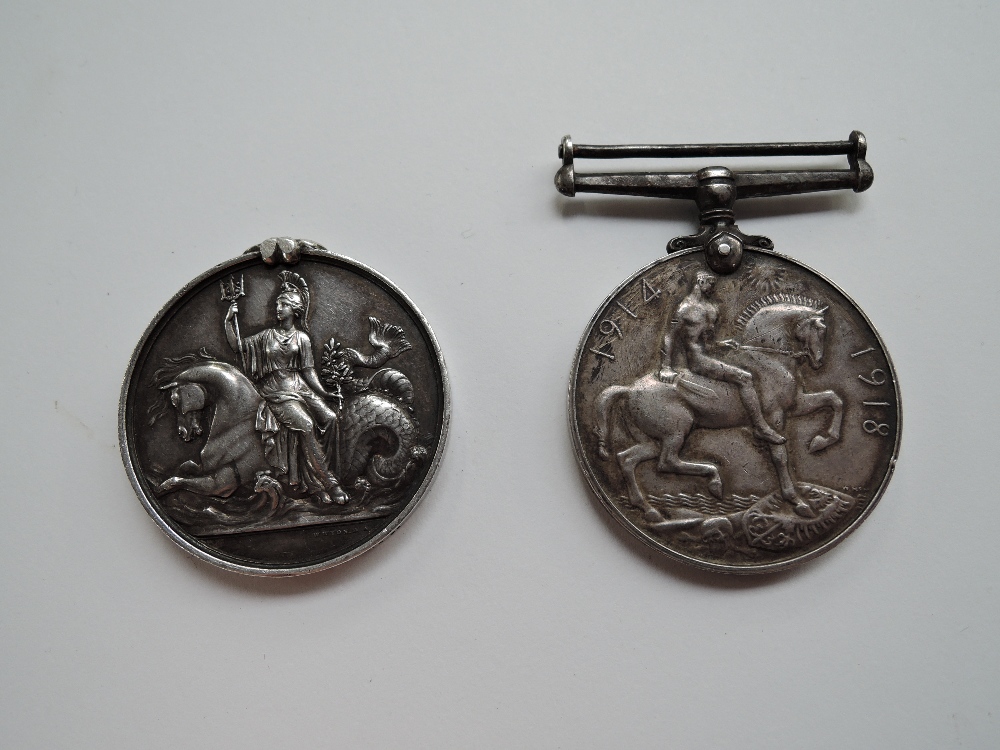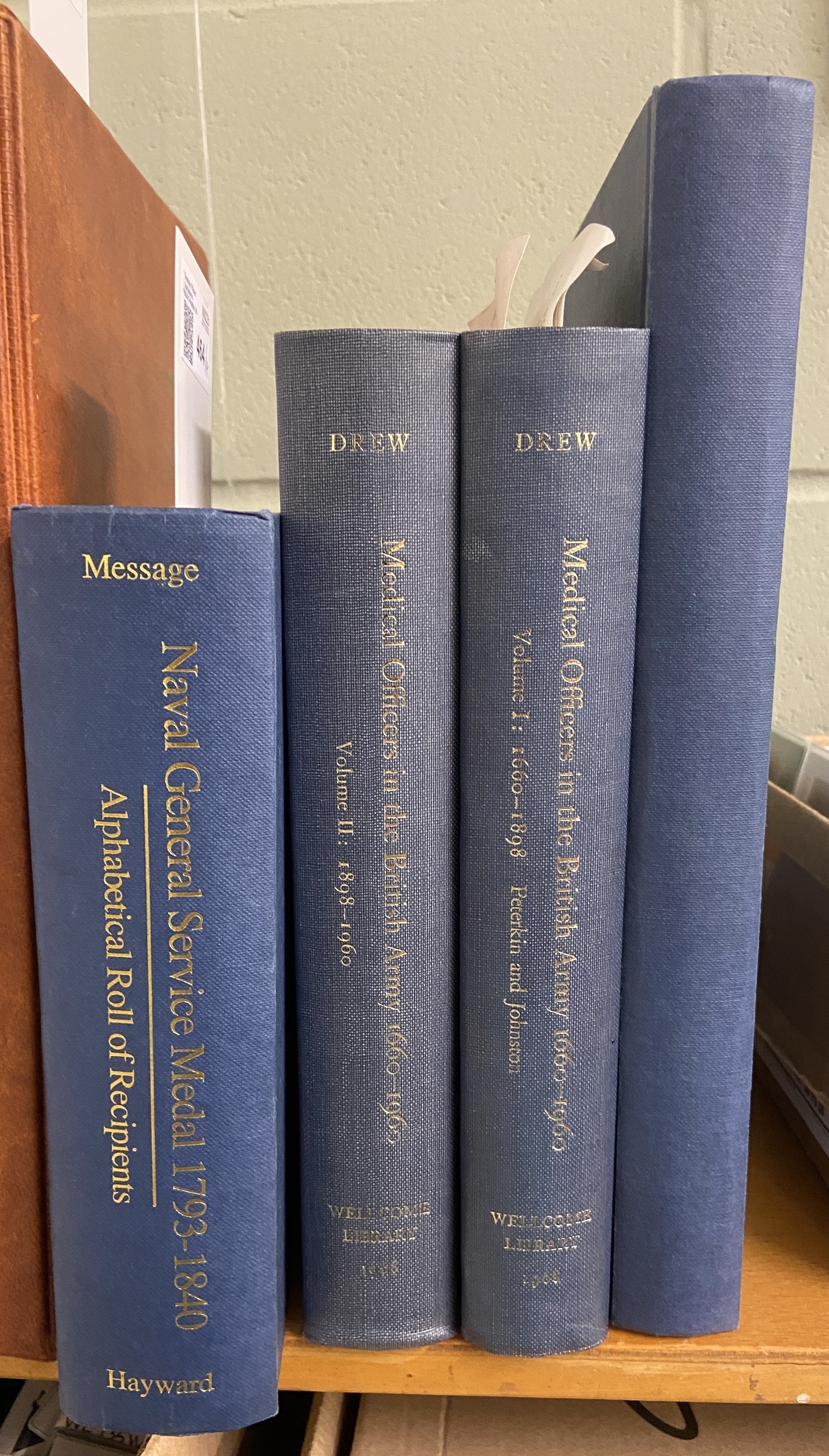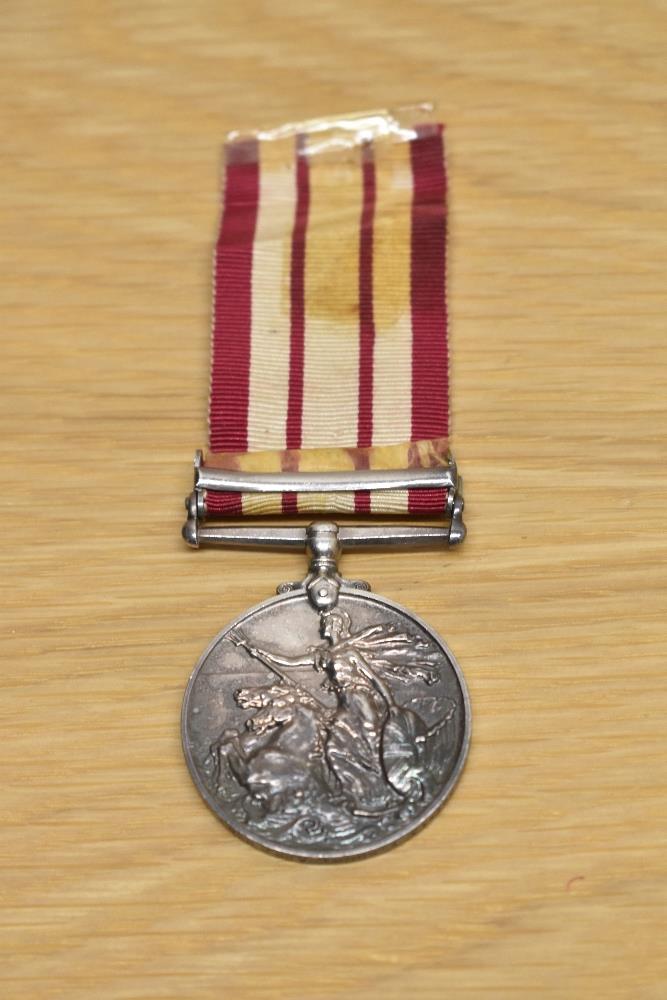NAVAL GENERAL SERVICE MEDAL, 1793-1840, single clasp, Navarino (W. C. Coffin, Midshipman.); officially impressed. Old cabinet tone, small reverse edge bruise at 10 o’clock and one or two tiny nicks, otherwise nearly extremely fine. William Chappell Coffin was born in January 1811 in Devonport, Devon. He entered the Navy on the 15th of April, 1824 coming aboard HMS Prince Regent as a Volunteer 1st Class, aged 13, and was promoted to the rank of Midshipman on the 1st of August that year. He moved to HMS Cambrian (40) on the 7th of September 1824, and served aboard that vessel for a total of nearly four years on the Mediterranean station. Midshipman Coffin was present at the Battle of Navarino on the 20th of October, 1827, as part of the combined British, Russian and French fleet under Vice-Admiral Sir Edward Codrington - sent to engage the Ottoman fleet lying in Navarino Bay. During this battle (the last to be fought entirely under sail) the British & Allied fleet’s superior firepower & training led to the destruction of the opposing fleet - three quarters of the 78 Ottoman vessels were sunk, and only 8 remained worthy of repair. The British suffered 181 killed and 480 wounded, and whilst several British and Russian battle ships required serious repair, none were sunk. Contrastingly, Ottoman casualties were considered to be as high as 3,000 killed, 1,109 wounded, as stated by Letellier in his report to Codrington. HMS Cambrian, located towards the left of the British line, attacked its opposing vessels and also helped silence the shore batteries nearby, but only suffered fairly light casualties of one killed and one wounded. Soon after, Midshipman Coffin was present aboard HMS Cambrian during the attack made upon a pirate stronghold at Gramvousa (or Grabusa), an island stronghold off the northwest coast of Crete. During the Greek wars of Independence, a population of some 400 Cretan rebels had taken control of the old Venetian fort (previously garrisoned by Ottoman troops) located on the crest of a mountain, and due to the lack of resources present on the island, were engaging in piracy in the strategic straits between Gramvousa and Antikythyra. A taskforce of 6 British and 2 French ships under Commodore Sir Thomas Staines was duly sent by the Governor Ionnnis Capodistrias to pacify the pirates, and all 14 Greek pirate vessels were destroyed in the sheltered harbour, and two merchantmen (Ionian & Austrian) were secured, the booty returned to Malta for claims. Unfortunately, having secured the stronghold, HMS Isis struck Cambrian, causing her to broadside the rocks in the narrow channel. The ship settled in shallow water and the entire crew was safely removed before strong swell then subsequently broke her up. William Coffin served aboard numerous other ships and packets, being promoted to the rank of Mate aboard HMS Kent on the 7th of October 1830, and he appears to have received a severe wound to his right eye in an unrecorded incident which took place aboard HMS Scorpion c.1836. He was promoted to the rank of Lieutenant on the 23rd of November 1841, and began to receive a pension for wounds of 27l/7s/6d as of the 14th of March 1842. Genealogical research suggests he was married early 1842, just prior to serving for three years as First Lieutenant aboard HMS Scylla (18) on the North American and West Indies station under Captain Robert Sharpe, which proved his last serious post before retirement. He is shown in the 1851 Census as living in Plymouth, as Lieut. RN on half-pay, at the age of 40, and is not long afterwards recorded as having died in Calcutta, India, as noted in the London Standard, Monday 8th August, 1853: “Lieutenant William Chappel Coffin (1841) died on the 14th of June at Calcutta. He was admiralty agent in a contract mail-packet, and was in receipt of a pension for wounds.” (© The British Library Board). Sold with copy O’Byrne entry, detailed service papers and other useful research.
NAVAL GENERAL SERVICE MEDAL, 1793-1840, single clasp, Navarino (W. C. Coffin, Midshipman.); officially impressed. Old cabinet tone, small reverse edge bruise at 10 o’clock and one or two tiny nicks, otherwise nearly extremely fine. William Chappell Coffin was born in January 1811 in Devonport, Devon. He entered the Navy on the 15th of April, 1824 coming aboard HMS Prince Regent as a Volunteer 1st Class, aged 13, and was promoted to the rank of Midshipman on the 1st of August that year. He moved to HMS Cambrian (40) on the 7th of September 1824, and served aboard that vessel for a total of nearly four years on the Mediterranean station. Midshipman Coffin was present at the Battle of Navarino on the 20th of October, 1827, as part of the combined British, Russian and French fleet under Vice-Admiral Sir Edward Codrington - sent to engage the Ottoman fleet lying in Navarino Bay. During this battle (the last to be fought entirely under sail) the British & Allied fleet’s superior firepower & training led to the destruction of the opposing fleet - three quarters of the 78 Ottoman vessels were sunk, and only 8 remained worthy of repair. The British suffered 181 killed and 480 wounded, and whilst several British and Russian battle ships required serious repair, none were sunk. Contrastingly, Ottoman casualties were considered to be as high as 3,000 killed, 1,109 wounded, as stated by Letellier in his report to Codrington. HMS Cambrian, located towards the left of the British line, attacked its opposing vessels and also helped silence the shore batteries nearby, but only suffered fairly light casualties of one killed and one wounded. Soon after, Midshipman Coffin was present aboard HMS Cambrian during the attack made upon a pirate stronghold at Gramvousa (or Grabusa), an island stronghold off the northwest coast of Crete. During the Greek wars of Independence, a population of some 400 Cretan rebels had taken control of the old Venetian fort (previously garrisoned by Ottoman troops) located on the crest of a mountain, and due to the lack of resources present on the island, were engaging in piracy in the strategic straits between Gramvousa and Antikythyra. A taskforce of 6 British and 2 French ships under Commodore Sir Thomas Staines was duly sent by the Governor Ionnnis Capodistrias to pacify the pirates, and all 14 Greek pirate vessels were destroyed in the sheltered harbour, and two merchantmen (Ionian & Austrian) were secured, the booty returned to Malta for claims. Unfortunately, having secured the stronghold, HMS Isis struck Cambrian, causing her to broadside the rocks in the narrow channel. The ship settled in shallow water and the entire crew was safely removed before strong swell then subsequently broke her up. William Coffin served aboard numerous other ships and packets, being promoted to the rank of Mate aboard HMS Kent on the 7th of October 1830, and he appears to have received a severe wound to his right eye in an unrecorded incident which took place aboard HMS Scorpion c.1836. He was promoted to the rank of Lieutenant on the 23rd of November 1841, and began to receive a pension for wounds of 27l/7s/6d as of the 14th of March 1842. Genealogical research suggests he was married early 1842, just prior to serving for three years as First Lieutenant aboard HMS Scylla (18) on the North American and West Indies station under Captain Robert Sharpe, which proved his last serious post before retirement. He is shown in the 1851 Census as living in Plymouth, as Lieut. RN on half-pay, at the age of 40, and is not long afterwards recorded as having died in Calcutta, India, as noted in the London Standard, Monday 8th August, 1853: “Lieutenant William Chappel Coffin (1841) died on the 14th of June at Calcutta. He was admiralty agent in a contract mail-packet, and was in receipt of a pension for wounds.” (© The British Library Board). Sold with copy O’Byrne entry, detailed service papers and other useful research.















Try LotSearch and its premium features for 7 days - without any costs!
Be notified automatically about new items in upcoming auctions.
Create an alert